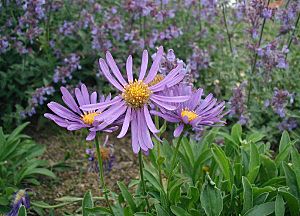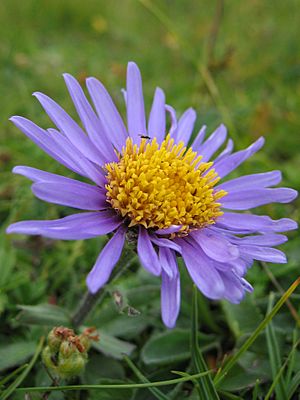Alpine aster facts for kids
Quick facts for kids Alpine aster |
|
|---|---|
 |
|
| Conservation status | |
| Scientific classification | |
| Genus: |
Aster
|
| Species: |
alpinus
|
| Synonyms | |
|
|
The Aster alpinus, also known as the alpine aster or blue alpine daisy, is a beautiful flowering plant. It belongs to the daisy family, Asteraceae. This plant naturally grows in the mountains of Europe, including the famous Alps. You can also find a type of this plant in Canada and the United States.
The alpine aster is a type of herbaceous plant, which means it has soft stems instead of woody ones. It is also a perennial, meaning it lives for more than two years. Its lovely flowers can be purple, pink, or blue, and they bloom during the summer months.
Contents
What Does the Alpine Aster Look Like?
The alpine aster grows in clumps, forming a neat mound of leaves and flowers. It usually reaches a height of about 10 to 35 centimeters (4 to 14 inches). The flowers can be various shades of blue, indigo, violet, white, or pink.
This plant is so pretty and easy to grow that it has won a special award. The Royal Horticultural Society in the UK gave it their Award of Garden Merit. This award means it's a great plant for gardens.
Where Does the Alpine Aster Grow?
The alpine aster grows slowly in different types of soil. It likes soils like clay, silt, and loam. It prefers soil that is slightly acidic to slightly alkaline, with a pH between 6 and 7.5. This plant grows upright, usually with a single main stem.
It thrives best in cooler climates, which makes sense since it's called the "alpine" aster. It can handle many soil types, including sandy loam and clay loam. It also prefers soil that isn't too rich in nutrients. The plant can survive cold temperatures down to about -28°C (-18.4°F). For it to grow well, it needs at least 90 days without frost. It can also survive medium-level fires.
Who Likes This Plant?
The alpine aster is a herbaceous plant, meaning it has soft stems. It is very attractive to many different creatures. Bees love to visit its flowers to collect nectar. Butterflies are also drawn to its bright colors. Even some birds enjoy visiting this plant.
Protecting the Alpine Aster
The conservation status of plants tells us how safe they are from disappearing. NatureServe is an organization that tracks this. They list one type of alpine aster, Aster alpinus var. vierhapperi, as "Secure Variety" in Canada. This means it's generally safe there.
However, in some specific places, it's more at risk. In Ontario, Canada, it is "Critically Imperiled," meaning it's in great danger. In Alberta, Canada, it is "Vulnerable." In the United States, this variety is also "Critically Imperiled" in Colorado and Wyoming. This shows that while the plant is generally secure, some local populations need protection.
See also
 In Spanish: Aster alpinus para niños
In Spanish: Aster alpinus para niños



